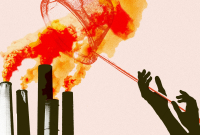Support strong Canadian climate journalism for 2025
The federal government has given British Columbia’s carbon dioxide storage regulations its stamp of approval. Now, companies pursuing carbon capture and utilization projects in the province can apply for the federal investment tax credit to help cover the cost of the pricey equipment needed to capture carbon from industrial processes and store it underground.
A Finance Canada memo dated Sept. 26, 2022 shared with Canada’s National Observer revealed Environment and Climate Change Canada (ECCC) reviewed the province’s regulations at the request of B.C. officials.
Less than two months later, ECCC notified B.C.’s Ministry of Energy, Mines and Low Carbon Innovation that the regulations passed muster. Saskatchewan and Alberta are the only other jurisdictions currently eligible for the carbon capture utilization and storage investment tax credit.
The investment tax credit — worth an estimated $8.6 billion — was proposed in the federal Budget 2022 and will help companies cover up to 50 per cent of the cost of investing in CCUS equipment used for storing CO2 underground or injecting it into cement.
To store CO2 underground, it is compressed into a liquid-like form and injected into geological formations generally more than a kilometre deep. In B.C., CO2 would most likely be injected into depleted natural gas pools or saline aquifers (layers of porous rocks saturated with salty water).
A group of experts from ECCC and Natural Resources Canada spent several months in 2022 evaluating whether B.C.’s regulatory framework aligns with international best practices, ECCC told Canada’s National Observer in an emailed statement.
The federal government considered earthquake risks and other geological elements as part of the review process and concluded the province has sufficient regulatory requirements to ensure safe and permanent CO2 storage, the statement said.
The Pacific Coast west of Vancouver Island is the most earthquake-prone region in Canada, according to Natural Resources Canada’s website. “Seismic activity is one of the key considerations in determining appropriate locations for carbon capture storage projects in B.C.,” B.C.’s Ministry of Energy, Mines and Low Carbon Innovation told Canada’s National Observer in an emailed statement.
New research from GeoScience BC and the BC Centre for Innovation and Clean Energy found 4,230 megatonnes of carbon dioxide could potentially be stored in formations in northeast British Columbia, particularly in depleted oil and gas pools and deep saline aquifers around Fort St. John and Dawson Creek. The B.C. government, the federal government and Shell Canada each committed $35 million to the BC Centre for Innovation and Clean Energy when it launched in 2021. One of its three board members is Andrea Brecka, a longtime Shell employee and current vice-president of Shell Fleet Solutions in the Americas.
In B.C., “natural gas production is a key driver of economic growth” but processing the gas presents a “considerable source” of CO2 emissions, according to a government fact sheet. Advancing carbon capture is key so the province can continue to extract its gas resources, it says. Environmentalists warn that B.C. can’t achieve its climate goals if it continues to expand LNG operations and lock in high emissions.
Right now — worldwide and in Canada — most captured CO2 is used to force more oil out of mature oil wells. Increased oil production results in more planet-warming pollution because 80 per cent of the emissions are created when the fuel is burned, for example, to drive cars or heat buildings.
In Budget 2022, the federal government’s proposal for the investment tax credit said enhanced oil recovery was not an eligible use of CO2. Additional details published in August show that CCUS projects doing enhanced oil recovery can still receive funding, but the tax credit will be reduced based on how much of the CO2 goes towards ineligible uses.
Natasha Bulowski / Local Journalism Initiative / Canada’s National Observer







Comments